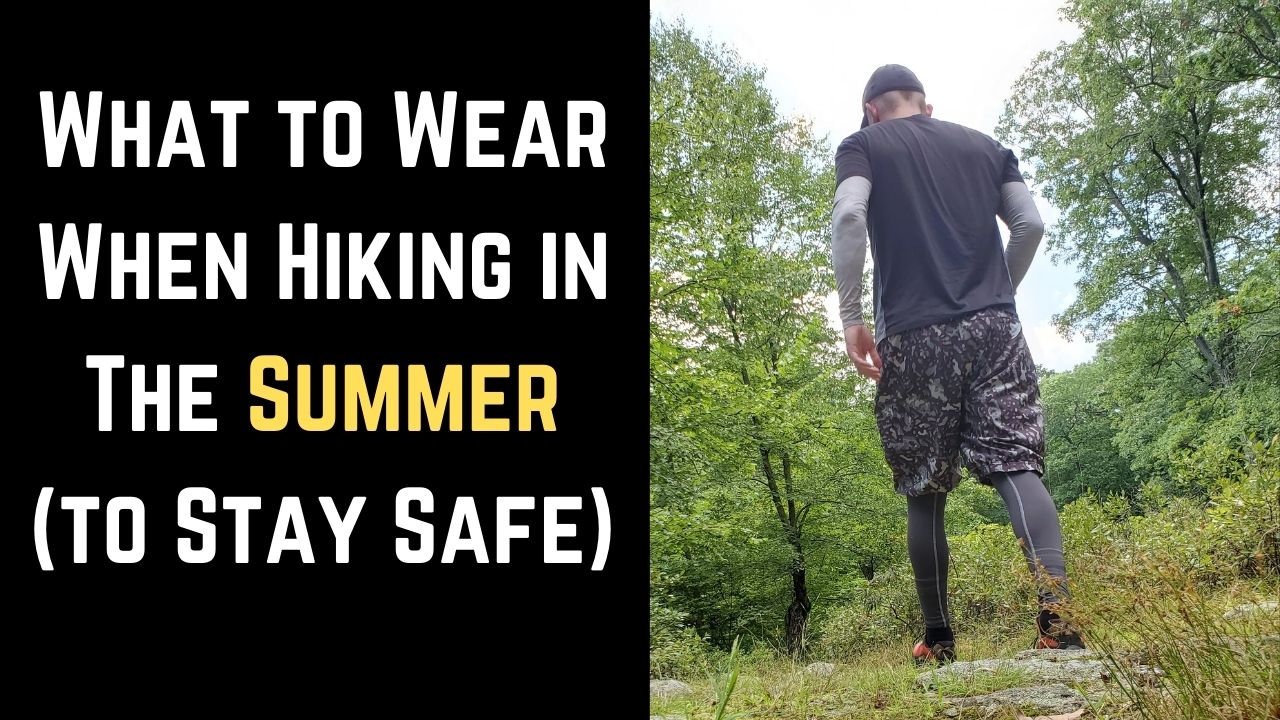What to Wear When Hiking in The Summer to Stay Cool

I have personally found knowing what to wear when hiking in the summer is critical to your safety in more ways than one and in this post, I’d like to share exactly how I tackle this subject.
First, let me just say that in my personal experience, hiking in the summer carries more dangers than when hiking in the winter. Here’s just a few of those risks:
 Let’s cover the different parts of the body (from top to bottom):
Let’s cover the different parts of the body (from top to bottom):

- You sweat and dehydrate easier (more cramps, passing out risk).
- You can get a sunstroke easier (or sunburns).
- Animals (like bears) are usually more active in the summer.
- You generally have to carry more stuff (like water and food) in order to stay hydrated and full.
Here’s what you need to wear when hiking in the summer:
 Let’s cover the different parts of the body (from top to bottom):
Let’s cover the different parts of the body (from top to bottom):
- Head: Cap is usually fine.
- Body: I like wearing a rash guard shirt or t shirt (mostly polyester).
- Waist: Rashguard underwear.
- Legs: Leggings with shorts over them or regular sports pants (I wear under armor).
- Feet: I always wear waterproof socks and trail running shoes.
- 3 liter hydration pack (for 10 miles).
- 1-2 bottles of a hydration drink with pH flour salts (or Gatorade).
- 2-3 energy bars for a 10 mile hike.
- Bear spray.
- Compass.
- Soap when I change shirts (I can’t stand running out sweaty in the summer for too long).
Details of why I wear what I wear on my summer hikes:

1) Head: Cap.
In case you didn’t know, I’m pretty bald and running around in the summer, under the sun for too long is very dangerous for me. In fact, even if you have a head full of hair, it’s never a good idea to run with the sun shining over your head for too long. A cap protects your head from the rays and while yes, your head will get hot overtime, you can easily remove the cap when running past a stream and douse yourself with cold water to cool off. When you get to places in your hike where there’s shade, you can certainly take off your cap there.2) Body: Why I like wearing a rash guard shirt (or polyester shirt):
I generally do not like sweating too much and a rash guard shirt is great at absorbing it. In addition, rash guard shirts also compress my muscles so there’s less chances of aches, especially when I do long hikes. And just as well, rash guard shirts are very comfortable to wear in any weather environment (I love wearing them when I hike in the rain too or in the winter time). Now I also do wear a polyester shirt, but I’ll typically use that a secondary shirt when I change mid way into my hikes. A cotton shirt feels like an oven when worn in the summer, but a polyester one feels great even when you’re sweating (it’s also good against bugs).3) Waist: Rash guard underwear.
“That” part of your body is going to sweat a lot and it’s also in the most enclosed area of your body anyway. To me, wearing a rash guard underwear is usually very comfortable and it prevents a lot of rashes from wearing normal underwear.4) Legs: Rash guard leggings with shorts over it and/or under armor pants.
If it looks like it’s going to be a very hot summer hike, I’ll usually wear the first option and if I know I’m going to be in areas with a lot of shade and finish my hike when it gets colder, I’ll likely wear the second option. I prefer to wear one of these 2 options for a few reasons:- First, it’s comfortable and I can run pretty comfortably with it.
- Second, it protects me from bugs, possibly tick bites and gives me less chances of scraping against sharp rocks or poison ivy plants. I will never understand how people can walk around with a lot of skin showing on a hike. Even if you look great and bring bug spray, it’s still a dumb idea because you put yourself in unnecessary danger. Bugs are everywhere when you go hiking (some could be poisonous), especially in the summer so wear at least leggings to protect your skin.
